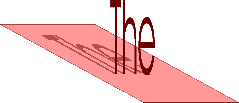


|
|
 |
|
| "The most stereotypical feature of northern British English dialects, especially those of Yorkshire and Lancashire [is] the occurrence of vowel-less forms of the definite article." Jones (2002: 325) |
| allophone: term used to describe any variant
of a single phoneme. For example, in English, <a> is nasalized (realized
as [ |
| oblique case: denotes any case other than nominative (or vocative). |
| levelling : the process whereby less regular forms, influenced by more common forms, change to fit the uniform pattern. |
Before examining the phenomenon of vowel-less articles it might be appropriate to consider the definite article as it exists in standard British English.
The Standard English form
Barry (1972) makes the point that, in Standard English, the accentuated definite
article takes the form [![]() ]
and that there are two principle allophones
]
and that there are two principle allophones
[
] when an initial vowel immediately follows (e.g. "the evening").
[] when followed by an initial consonant (e.g. "the car").
The origins of these forms are thought to lie in Old English (OE) sē, originally employed as a demonstrative but which subsequently came to be used an article sometime prior to the commencement of the Middle English (ME) period. e
| Middle English : the term applied to the language as it was spoken in the period running approximately from 1150 to 1500., |
As can be seen from Table 1, within the demonstrative paradigm the
oblique cases all possessed initial þ or ð. Both
are believed to have been generally realized as [![]() ] (see below) and it is supposed that the [s] of s
] (see below) and it is supposed that the [s] of s![]() came to be pronounced as [
came to be pronounced as [![]() ] through
the process of levelling.
] through
the process of levelling.
Table 1
|
Case
|
Singular
|
Plural | ||
| Masculine | Feminine | Neuter | All genders | |
| Nominative | sē | sēo | ðæt | ðā |
| Accusative | ðone | ð |
ðæt | ðā |
| Genitive | ðæs | ðǣre | ðæs | ðāra |
| Dative | ðǣm | ðǣre | ðǣm | ðǣm |
| Instrumental | ðy, ðon | -- | ðy, ðon | -- |
|
After Baugh and Cable 1993: 57, 15 |
Jones (2000) supports the notion concerning the pronunciation of þ and ð on the grounds that:
*Barry (1972) adds that the voicing of þ (from [![]() ]
to [ð]) is generally ascribed to the loss of stress. The theory is that
the [ð] pronunciation subsequently extended from the stressed forms to the
stressed ones. Dobson (1968) [cited by Barry] suggests that the voiced realization was universal
by the 14th century.
]
to [ð]) is generally ascribed to the loss of stress. The theory is that
the [ð] pronunciation subsequently extended from the stressed forms to the
stressed ones. Dobson (1968) [cited by Barry] suggests that the voiced realization was universal
by the 14th century.
With regard to the evolution of the SE unstressed varieties ([![]() ]
and [
]
and [![]() ]), Barry suggests
that these arose from changes to the stressed form [
]), Barry suggests
that these arose from changes to the stressed form [![]() ]
in the following way:
]
in the following way:
| The vowel [e(:)] of s |
Definite Article Reduction
Although not investigated to any great depth, Barry claims that it may be generally
accepted that the voicing of OE þ mentioned above failed to occur
in the north, and the pronunciation thus remained as [![]() ]
The evolution of the [t] form (see below) subsequently followed, though the
timing of this development is uncertain. However, whilst in some districts it
occurred before both a vowel and a consonant in others it appeared only before
a vowel. A more detailed discussion of the origins of DAR can be found in the
Evolution page.
]
The evolution of the [t] form (see below) subsequently followed, though the
timing of this development is uncertain. However, whilst in some districts it
occurred before both a vowel and a consonant in others it appeared only before
a vowel. A more detailed discussion of the origins of DAR can be found in the
Evolution page.
The following map is based on the findings of Ellis (1889) and illustrates the distribution of the varying forms of DAR.
 |
After Barry (1972: 168) |
Barry, however, opines that this map is a very much a "broad generalisation" noting, inter alia, that Ellis:
These aspects are examined in greater detail under Variation of the Definite Article in Northern English.
It is important to note that the majority of dialects employ more than one reduced form. The examples in Table 2 have been drawn from the material accumulated during the Survey of English Dialects (SED).
Table 2
| Form | |
| Supralaryngeal forms | [ |
| Laryngeal * | [ |
| Affricated | [ |
| Hybrid (laryngeal and supralaryngeal) | [ |
|
After Jones 2002: 326
|
|
*Jones explains his use of this term as opposed to 'glottal
stop' on the grounds that realization does not necessarily involve solely
the glottis or even total closure
|
The Future
Jones (2004) states that it is evident from the comparison of the Ellis (1889)
material with that of the SED that the area of DAR has contracted and that the
southern boundary of this region has shifted slightly to the north. Whilst it
is clear that all DAR speakers thus far encountered in the recordings to date
use both the standard form the as well as the DAR variety, it is uncertain
why the reduced forms fall out of use. Nevertheless, Jones (2004) is of the
opinion that DAR is likely to remain in use in the North for the foreseeable
future.
Sources
Barry, M. V. (1972) The Morphemic Distribution of the Definite Article in
Contemporary Regional English. In M. F. Wakelin (Ed) Patterns in the
Folk Speech of the British Isles, (1972) London: The Athlone Press.
Dobson, E. J. (1968) English Pronunciation, Second Edition, Oxford: Oxford University Press.
Ellis, A. J. (1889) On Early English Pronunciation, vol. V. Early English Text Society. London: Trübner and Co.
Jones, M. J. (2000) An acoustic study of definite article reduction (DAR) in Sheffield dialect. Unpublished paper presented at the VIEW 2000 conference, University of Essex, September 2000.
Jones, M. J. (2002) The origin of Definite Article Reduction in northern English dialects: evidence from dialect allomorphy. English Language and Linguistics 6.2: 325-345.
Jones, Mark J. (2004). The phonetics and phonology of Definite Article Reduction in northern English dialects. Unpublished PhD dissertation, University of Cambridge
Jones, W. E. (1950) An investigation into the Phonetics of the Definite Article in Yorkshire. Unpublished MA Thesis, University of |Leeds.